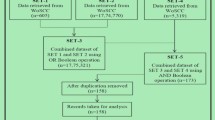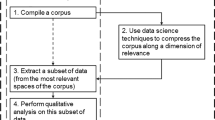Abstract
We describe a new method of reduced Google matrix which allows to establish direct and hidden links between a subset of nodes of a large directed network. This approach uses parallels with quantum scattering theory, developed for processes in nuclear and mesoscopic physics and quantum chaos. The method is applied to the Wikipedia networks in different language editions analyzing several groups of political leaders of USA, UK, Germany, France, Russia and G20. We demonstrate that this approach allows to recover reliably direct and hidden links among political leaders. We argue that the reduced Google matrix method can form the mathematical basis for studies in social and political sciences analyzing Leader-Members eXchange (LMX).
Similar content being viewed by others
References
http://www.wikipedia.org (accessed August 2016)
Encyclopaedia Britanica, http://www.britannica.com/ (accessed August 2016)
J. Giles, Nature 438, 900 (2005)
J.M. Reagle Jr., Good Faith Collaboration: The Culture of Wikipedia (MIT Press, Cambridge MA, 2010)
F.A. Nielsen, Wikipedia research and tools: review and comments (2012), available at SSRN: dx.doi.org/10.2139/ssrn.2129874
S. Brin, L. Page, Computer Networks and ISDN Systems 30, 107 (1998)
A.M. Langville, C.D. Meyer, Google’s PageRank and beyond: the science of search engine rankings (Princeton University Press, Princeton, 2006)
E. Gabrilovich, S. Markovitch, Computing Semantic Relatedness using Wikipedia-based Explicit Semantic Analysis, Proc. 20th Int. Joint Conf. Artificial Intelligence 7, 1606 (2007)
L. Ermann, K.M. Frahm, D.L. Shepelyansky, Eur. Phys. J. B 86, 193 (2013)
L. Ermann, K.M. Frahm, D.L. Shepelyansky, Rev. Mod. Phys. 87, 1261 (2015)
A.O. Zhirov, O.V. Zhirov, D.L. Shepelyansky, Eur. Phys. J. B 77, 523 (2010)
Y.-H. Eom, K.M. Frahm, A. Benczur, D.L. Shepelyansky, Eur. Phys. J. B 86, 492 (2013)
Y.-H. Eom, D.L. Shepelyansky, PLoS One 8, e74554 (2013)
Y.-H. Eom, P. Aragon, D. Laniado, A. Kaltenbrunner, S. Vigna, D.L. Shepelyansky, PLoS One 10, e0114825 (2015)
J. Lages, A. Patt, D.L. Shepelyansky, Eur. Phys. J. B 89, 69 (2016)
M.H. Hart, The 100: ranking of the most influential persons in history (Citadel Press, N.Y., 1992)
Academic Ranking of World Universities, http://www.shanghairanking.com/ (accessed Aug. 2016)
A.D. Chepelianskii, Towards physical laws for software architecture, arXiv:1003.5455 [cs.SE] (2010)
K.M. Frahm, D.L. Shepelyansky, Reduced Google matrix, arXiv:1602.02394 [physics.soc] (2016)
2012 G20 Los Cabos summit, https://en.wikipedia.org/wiki/2012˙G20˙Los˙Cabos˙summit (accessed Aug. 2016)
B.M. Bass, Bass & Stogdill’s Handbook of Leadership: Theory, Research and Managerial Applications, 3rd edn. (Free Press, N.Y., 1990)
G.B. Graen, M. Uhl-Bien, Leadership Quaterly 6, 219 (1995)
Complexity leadership, edited by M. Uhl-Bien, R. Marion (Inf. Age Publ. Charlotte North Carolina, USA, 2008)
The Oxford Handbook of Leader-Member Exchange, edited by T.N. Bauer, B. Erdogan (Oxford University Press, Oxford, 2016)
S. Dorogovtsev, Lectures on complex networks (Oxford University Press, Oxford, 2010)
B. Erdogan, T.N. Bauer, J. Walter, Personal Psychology 68, 185 (2015)
http://www.quantware.ups-tlse.fr/QWLIB/wikipolitnet/ (accessed Sept. 2016)
R. Meusel, S. Vigna, O. Lehmberg, C. Bizer, J. Web Sci. 1, 33 (2015)
V.V. Sokolov, V.G. Zelevinsky, Nucl. Phys. A 504, 562 (1989)
V.V. Sokolov, V.G. Zelevinsky, Ann. Phys. 216, 323 (1992)
C.W.J. Beenakker, Rev. Mod. Phys. 69, 731 (1997)
T. Guhr, A. Müller-Groeling, H.A. Weidenmüller, Phys. Rep. 299, 189 (1998)
R.A. Jalabert, Scholarpedia 11, 30946 (2016)
P. Gaspard, Scholarpedia 9, 9806 (2014)
K.M. Frahm, B. Georgeot, D.L. Shepelyansky, J. Phys. A: Math. Theor. 44, 465101 (2011)
P. Aragón, D. Laniado, A. Kaltenbrunner, Y. Volkovich, Biographical social networks on Wikipedia: a cross-cultural study of links that made history, in Proc. of the 8th Intl. Symposium on Wikis and Open Collaboration, WikiSym, 2012 (ACM, New York, 2012), No. 19
Author information
Authors and Affiliations
Corresponding author
Rights and permissions
About this article
Cite this article
Frahm, K.M., Jaffrès-Runser, K. & Shepelyansky, D.L. Wikipedia mining of hidden links between political leaders. Eur. Phys. J. B 89, 269 (2016). https://doi.org/10.1140/epjb/e2016-70526-3
Received:
Revised:
Published:
DOI: https://doi.org/10.1140/epjb/e2016-70526-3




